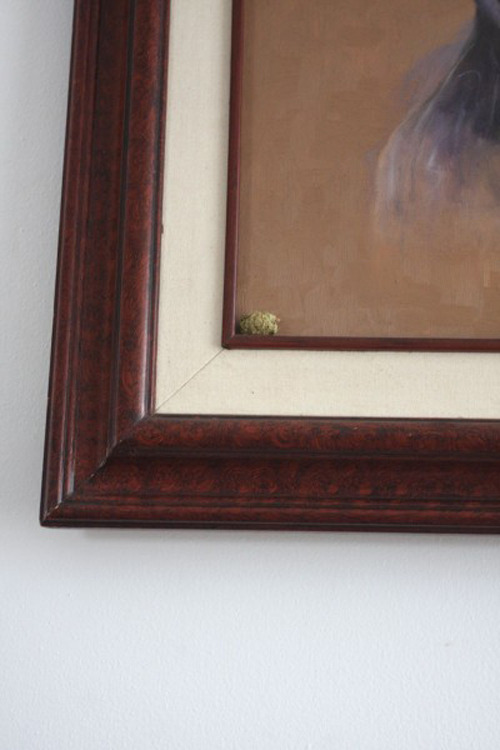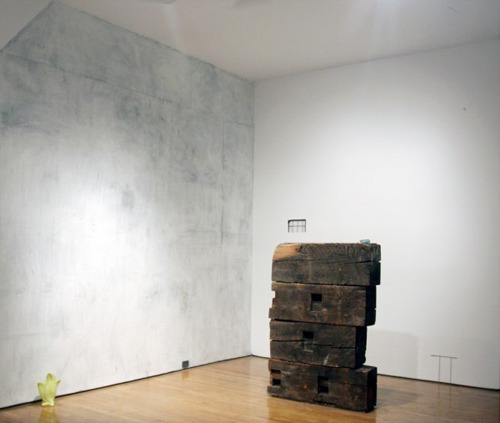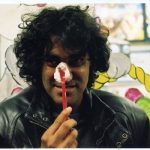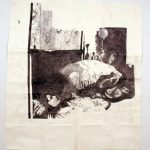Con Edison Immigrant Artist Program Newsletter, Issue No. 35
Featured Artist: Claudia Peña Salinas
Claudia Peña Salinas is a mixed media artist from Mexico who practices her art in both Mexico and New York City. Her work has been presented at institutions such as SOMA in Mexico City, El Museo del Barrio and the Queens Museum of Art. Claudia’s recent work with mixed materials involves a thoughtful and intuitive approach to combining objects and unlikely locations. She is interested in exploring the wide range of viewers reactions to these objects and continues to develop more ambitious projects to engage new spaces and wider audiences. Below, IAP Program Officer Karen Demavivas and Intern Pamela Hernandez interview Claudia.
IAP: You first started as a painter and then gravitated to installation work. Why did you get onto this particular path? How do installations better communicate what you want to express?
CS: I found my way into installation through photography. At some point I began to notice that the abstract paintings I was doing resembled or had a certain relation to the surroundings I was photographing. Like the duct taped broken door of the subway I would go through everyday on my way to the studio or the discarded Styrofoam shapes of packaging goods. I started by pairing the paintings and photographs together into clusters. Around this time I had the opportunity to make a large-scale installation in a two-wall room. For it I painted an architectural space with black paint on the walls that played off the existing elements, such as doors and signs. I then hung in small clusters throughout the space, paintings, photographs, found printed material and drawings.
Most of the photographs had been taken over the course of a year. In them I found macro and micro perspectives of a certain geometry or emotional architecture if you will, observed in the materials or relationships between objects. The paintings, drawings and collected pages followed that logic.
It was clear that here was a language for expression that allowed for a certain making that included both the outside everyday and the inside studio time. The materials could communicate a more direct process of making and the work having multiple entryways and associative elements, could organically unfold both in its making and in its reception.
IAP: On your website, you did not mention the location and further details of each installation. For example, there are no details on the work Cosas Extraviadas (2011). Please explain why.
CS: I take all the photographs of my work, and it is usually a difficult and lengthy process. So much of the work depends on the viewer existing in the space that translating that into a few images where I am dictating the order requires a remaking/rethinking of the piece. Also, I usually photograph it at the end of the show and I try to give more of a visual rather than verbal understanding (such as a description of the location) of the material.
IAP: How do you begin a new project? What goes into the research and planning before you put together an installation?
CS: I often begin with an object, an image or text that I find. It’s a very intuitive process, something catches my eye and from there a slew of associations and connections come together. For Objectos Extraviados, originally there was no project in mind. The objects included came from various parts of Mexico City I explored and were meaningful to me. I thought of them as a homeless collection. It was a sign in the metro station with that name that coalesced the idea of creating an archive of these lost/displaced objects.
For the one night event, I displayed the photographic archive of the objects in one part of the building and scattered the objects around the space and photographed them, the idea being that the objects could be encountered in different ways, through the image in the archive or in situ. This encounter could be one of chance: if not having seen the archive, the object could be taken, destroyed or simply ignored. The next day I went looking for them and re-photographed the sites. Some objects where damaged, others had disappeared and a few had moved around. The piece offered a very quiet and intimate relationship. I considered it a success if it managed to instill a moment of surprise in a few.

CS: I moved here with my family. My father was a corn and citrus farmer in Mexico and in the early 80’s the devaluation of the peso combined with a series of freezes that affected orange production made it difficult to remain in Mexico. My father immigrated to Chicago to work in construction and shortly we all joined. I went to a bilingual high school and what felt like a sort of in-between space, taking courses in both languages but immersed in neither. Most of my friends spoke Spanish and we kept to each other. I felt most comfortable and involved in the art classes, with its own language it was a good bridge between Spanish and English.
Later I went to the Art Institute of Chicago and studied painting. My move to the United States offered me a freedom to choose a certain path without the economical restraints I would have faced in Mexico. Here there were more opportunities and I was able to study with the help of financial aid and grants. I’m grateful for these opportunities, as I’ve been granted the ability to follow my creative drive.
IAP: Can you share some of the advantages and disadvantages you’ve experienced in practicing your art in your home country of Mexico versus here in New York City?
CS: I have worked mostly in the United States. Through involvement with various institutions in NYC, I’ve gained a strong community of artists that support my work. The New York art world, although at times overwhelming, is accessible to me via this tight knit community. My experience in Mexico City has been similar, due to SOMA, which I had the opportunity of attending last summer. The work that I made while there took the form of books, or documents of one-night events. I’m hoping to expand on the project that I began at SOMA. My time there gave me a certain curiosity and confidence about the place that I’d like to further explore.
IAP: You recently participated in the Queens Museum of Art Biennial with the installationTecolotl (2012). What was the experience like and how did this opportunity position you as an artist?
CS: It was a pleasure being part of “Three Points Make a Triangle.” The Queens Museum of Art commissioned Tecolotl and the curators Larissa Harris, Jamillah James and Manuela Moscoso were very supportive of the project. There was a level of trust established that allowed the project to develop organically. I originally visited Flushing and walked around the grounds of Corona Park as preparation for the piece. Some objects came from the park such as the Corona bottle caps placed in-between the railroad ties, the dirt in the gap between the wall and floor and a concrete blue paint rock from one of the fountains in the park. I am happy that a wider audience is able to access the work in this show. The Queens Museum is an interesting institution that hosts a variety of viewers.
IAP: What is your current relationship to gallery representation?
CS: At the moment I am not working with a particular gallery. I am grateful to have opportunities like the Queens Museum of Art and Forever & Today. My work is not entirely commodifiable and this has its challenges. It is important for me to keep the work itself as the first priority. I’m open to working with a gallery, as long as I am able to allow the work to continue to develop in an organic way.
This summer I will be showing a piece in a group show at Horton Gallery.
IAP: What are you working on now?
CS: Right now I am working on a new piece for an exhibition that opens in May. Anaranja was commissioned by Savannah Gorton and Ingrid Chu for Forever & Today, the not-for-profit space they run in the Lower East Side. For this piece I’m working with the color orange or “naranja” in Spanish. The color and the fruit have a strong memory for me. I was born in Montemorelos, a city in Mexico known as the citrus capital, and my family like most grew oranges.
I started by walking around the area near the gallery, mostly into Chinatown where I noticed the oranges placed as offerings in many shopkeepers’ Buddhist shrines and in the temples. There is a strong associative memory in the color, word, taste, and smell of the orange. In Chinese culture, orange also carries the associations of luck and prosperity. Prosperity is also embodied in the popular Japanese Maneki Neko, the cat waving a paw I also noticed in many shopkeepers’ windows.
On these walks, I have been collecting objects with orange color or form in my mind and working with them in the studio. I have also been photographing the oranges in their different forms and the cats that live in the shops, often engaging in brief conversations with the shopkeepers.
Along with this I’m working on a book that consists of photographs and short notations regarding the search for an orange blossom. Some of the motifs that run through the book are oranges, the number three, the color green and the seasons. The book includes walks around Chinatown, the Cloisters, friends’ studios and other day-to-day exchanges.
IAP: What is the next step in your career?
CS: Ideally, I would like to establish relationships with institutions and venues that can provide me with the time and support to realize more ambitious projects; these may be museums, non-profits, or galleries. I’m planning to return to Mexico City and realize a project within the community in which I’ve established there. In this regard I want to sustain a practice that can move between my home in NYC and Mexico City.





